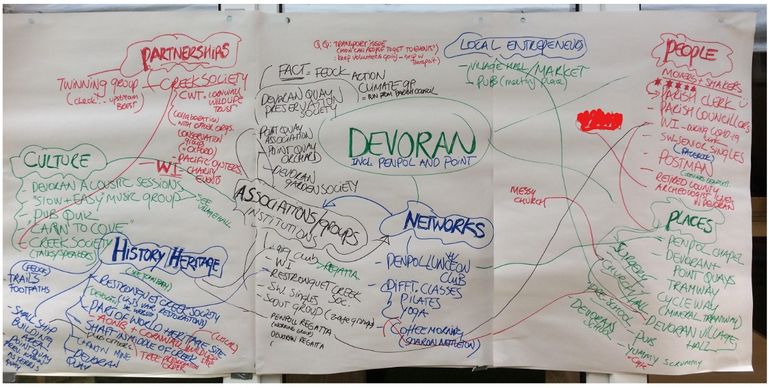LC 00811: verschil tussen versies
Geen bewerkingssamenvatting |
Geen bewerkingssamenvatting |
||
| Regel 33: | Regel 33: | ||
Examples: Community campaigns, community led planning proposals, and other activities that give the local community a voice. | Examples: Community campaigns, community led planning proposals, and other activities that give the local community a voice. | ||
[[Bestand:Neighbourhood Analysis in Feock.jpg|links|miniatuur| | [[Bestand:Neighbourhood Analysis in Feock.jpg|links|miniatuur|769x769px|Example of Neighbourhood Analysis in HAIRE's Feock (UK) pilot site ]] | ||
'''Tips''' | |||
'''Preparation for Neighbourhood Analysis Sessions''' | |||
· A separate space (e.g. room or outdoor area) for everyone to meet. | |||
· Large space to write (e.g. white board, black board or A0 paper). | |||
· Different coloured pens for the Neighbourhood Analysis’s eight different categories. | |||
· Set a fixed time for a Neighbourhood Analysis session. A 2-hour session is usually long enough to develop a useful brainstorm. | |||
{{Light Context | {{Light Context | ||
|Supercontext=LC_00810 | |Supercontext=LC_00810 | ||
Versie van 1 feb 2023 14:29
This page outlines key consderations for applying HAIRE's Neighbourhood Analysis approach. An expandable section on practical steps and tips follows.
The Neighbourhood Analysis Tool collates resources, as a brainstorm, that are available locally. The main aim is to show the assets that are available to a community, as told by the locals. Eight categories are used to organise responses. The categories and examples of resources that may be listed under them are summarised below:
People: Knowledge, skills, experiences, and expertise of certain individuals in the community. These perspectives are important to identify the skills and expertise from all groups and subgroups in the community. This includes all age groups and people who are specifically at risk of exclusion and marginalisation from being viewed as helpful.
Examples: recreational activities, professional activities, education, volunteering etc.
Places: Physical elements of the community such as community buildings and meeting rooms where activities take place and where people organise gatherings, meetings, etc.
Examples: Community building, church, (park) benches, hangouts etc.
Networks and informal links / connections: Networks in which people can communicate in a less formal manner. This covers the connection between the physical places where people can meet to discuss local problems/challenges.
Examples: Neighbourhood/community/village council and church community.
Partnerships: Collaborative forms of organisation and/or local partnerships. Focus on those networks and partnerships connecting the community and its members. Those connections promoting and supporting positive change are important.
Examples: Youth networks and regional social and/or economic development forums.
Associations, groups, institutions (organisations), and services: Local associations, community groups, recreational groups, clubs, tenant organisations, and other services run by institutions.
Examples: Schools, health centres, general practitioner, emergency services etc.
Local entrepreneurs: Economic connections in the community, including local companies, and business leaders.
Examples: Supermarket, local shops, tourism related companies etc.
Culture: Identifying important places, traditions, and activities that are of meaning to the community.
Examples: Museum, music, historical activities and festivals.
History and heritage: This category goes beyond a chronological history and considers examples of local action. The collation of such activity helps to put local experiences and knowledge into context and documents past processes, plans, and efforts for community development.
Examples: Community campaigns, community led planning proposals, and other activities that give the local community a voice.
Tips
Preparation for Neighbourhood Analysis Sessions
· A separate space (e.g. room or outdoor area) for everyone to meet.
· Large space to write (e.g. white board, black board or A0 paper).
· Different coloured pens for the Neighbourhood Analysis’s eight different categories.
· Set a fixed time for a Neighbourhood Analysis session. A 2-hour session is usually long enough to develop a useful brainstorm.
Referenties
- Neighbourhood Analysis During Covid-19, HAIRE, 1 februari 2023.


